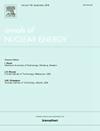压水堆燃料腐蚀相关不明沉积物及其相关安全问题 - II.腐蚀产物沉积和传热建模
IF 1.9
3区 工程技术
Q1 NUCLEAR SCIENCE & TECHNOLOGY
引用次数: 0
摘要
燃料包壳上的 CRUD 沉积物是核电站功率偏移和局部腐蚀的主要原因。本文是关于腐蚀产物沉积及其相关安全问题的三部分研究中的第二部分。本文提出了预测 CRUD 生长和内部传热传质的分析模块。CRUD 的增长取决于腐蚀产物沉积、流动侵蚀和化学平衡之间的动态平衡。在多模块迭代中,首先更新 CRUD 厚度,然后更新内部温度和浓度场。温度会影响 CRUD 表面的化学平衡、沉积平衡和侵蚀平衡。实验结果验证了耦合方法的准确性和可靠性。之前的实验结果与计算结果之间的有效热导率差值小于 0.4384 W/(m×K),WALT Loop 结果与计算结果之间的包层温度相对误差小于 1%。评估了运行条件的影响。pH 值较低的冷却液会降低腐蚀产物的溶解度,从而导致较高的 CRUD 厚度。CRUD 增长的主要来源是可溶性沉淀,因为可溶性沉淀形成的 CRUD 沉积物比相同浓度的不溶性颗粒形成的 CRUD 沉积物更厚。高热流量会增加 CRUD 的增长、内部芯棒的沸腾和硼的藏匿。反应器应用范围内的氢气对 CRUD 生长、芯沸腾和硼藏匿的影响微乎其微。这项研究为进一步了解 CRUD 的生长及其内部的多重物理现象提供了一种精确的方法,以缓解与 CRUD 相关的安全问题。本文章由计算机程序翻译,如有差异,请以英文原文为准。
Pressurized water reactor fuel corrosion-related unidentified deposit and its related safety issues – II. Corrosion product deposition and heat transfer modeling
CRUD depositions on fuel cladding are the main cause of power shift and localized corrosion in nuclear power plants. This paper is the second of a three-part study concerning the deposition of corrosion products and its related safety issues. In this paper, analytical modules are proposed to predict CRUD growth and internal heat and mass transfer. CRUD growth depends on dynamic balance between corrosion product deposition, flow erosion and chemical equilibrium. In the multi-module iteration, the CRUD thickness is updated first followed by internal temperature and concentration fields. Temperature affects the chemical equilibrium, deposition and erosion equilibrium on CRUD surfaces. The accuracy and reliability of the coupling method are verified by experimental results. The difference of effective thermal conductivity between previous experimental results and calculation results is less than 0.4384 W/(m × K) and the cladding temperature relative error between WALT Loop results and calculation results is less than 1 %. The influences of operation conditions are evaluated. Coolant with lower pH reduces corrosion product solubility leading to high CRUD thickness. The main source of CRUD growth is from soluble precipitation, because CRUD depositions formed from soluble precipitation are thicker than those from the insoluble particles of the same concentration. High heat flux increases CRUD growth, internal wick boiling and boron hideout. Hydrogen in reactor application range has a minimal meaningful effect on CRUD growth, wick boiling and boron hideout. This study provides a precise method for further understanding CRUD growth and its internal multi-physical phenomena to alleviate CRUD-related safety issues.
求助全文
通过发布文献求助,成功后即可免费获取论文全文。
去求助
来源期刊

Annals of Nuclear Energy
工程技术-核科学技术
CiteScore
4.30
自引率
21.10%
发文量
632
审稿时长
7.3 months
期刊介绍:
Annals of Nuclear Energy provides an international medium for the communication of original research, ideas and developments in all areas of the field of nuclear energy science and technology. Its scope embraces nuclear fuel reserves, fuel cycles and cost, materials, processing, system and component technology (fission only), design and optimization, direct conversion of nuclear energy sources, environmental control, reactor physics, heat transfer and fluid dynamics, structural analysis, fuel management, future developments, nuclear fuel and safety, nuclear aerosol, neutron physics, computer technology (both software and hardware), risk assessment, radioactive waste disposal and reactor thermal hydraulics. Papers submitted to Annals need to demonstrate a clear link to nuclear power generation/nuclear engineering. Papers which deal with pure nuclear physics, pure health physics, imaging, or attenuation and shielding properties of concretes and various geological materials are not within the scope of the journal. Also, papers that deal with policy or economics are not within the scope of the journal.
 求助内容:
求助内容: 应助结果提醒方式:
应助结果提醒方式:


